Almost 15 years ago, I signed up for my first Kathy Shaner workshop. I’d been informally studying with Kathy for some time – this would be my first opportunity to work with her on one of my own trees. Or soon to be mine. The trees for the event were included with workshop registration – ume from Muranaka Bonsai Nursery in Nipomo, CA. I drew the second largest tree of the lot. I was happy. It had a large trunk that split to three trunks/branches above. And I was told to expect double pink flowers.
Several years passed – no flowers. I’d already carved away the lower 3-4 inches of the trunk and begun developing the nebari. I carved the trunk and helped new branches ramify. But no blooms. I’ll admit I’m no fan of double pink, but the point of ume is the contrast between new flowers and old trunk. So I started grafting.
Another 5 years passed. The tree looked great with white blossoms – the fragrance was unforgettable – and I’d had fun learning how to care the variety. But ume don’t bud back well, and the grafting became a regular affair. Then, out of nowhere, a few dark buds appeared from some of the original branches. Before long, I saw the first few double pink flowers. Which confirmed my decision to graft.
This year I’m mid- re-grafting the entire tree. I let the branches grow past where I can safely cut back so I’m essentially starting from scratch. Here’s the tree a few weeks ago with the last few white and pink blossoms.

Ume – early February
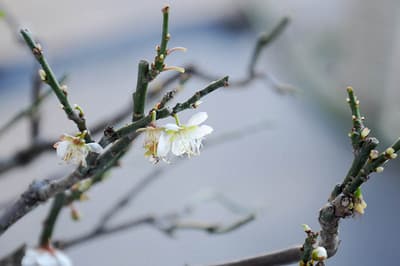
White flowers
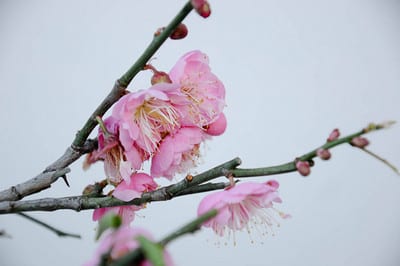
Double pink flowers
Last year I had good luck with my grafts – over half took and I ended up with around 7 new shoots. Another dozen or so grafts and I’ll be back in business.
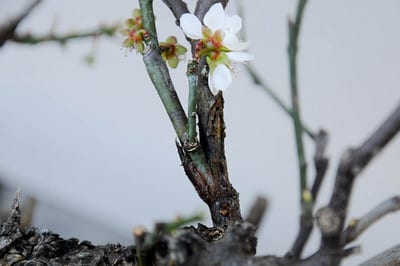
Scion – one year after grafting
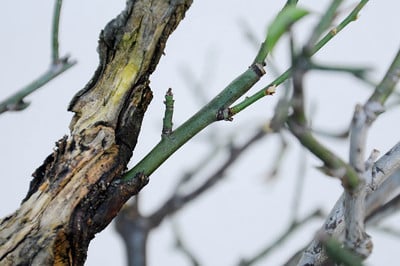
Another one-year old scion
Typically I graft in years when I don’t repot. This is supposed to maintain the vigor of the tree and help push energy to the scions. I hadn’t repotted the tree in a few years – not a problem because the pot was large and the drainage good – but I remembered doing things differently the first time I grafted the tree.
I looked through old photographs and found that when I grafted I cut the branches back heavily and repotted at the same time. I thought I’d try the same this year. Here’s a shot from below half-way through cleaning the bottom of the rootball. Not standard practice, but clearly demonstrative of the amount of roots removed.
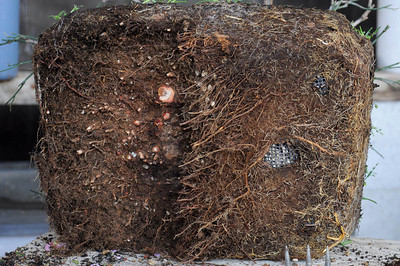
Half-way through the rootball
I removed all roots up to the base of the trunk. I knew the base of the tree was flat because I hand carved through three inches of wood ten years ago and still remember the blisters. The work was far easier this time. To further encourage outward growing roots, I removed all growth from the base of the trunk.
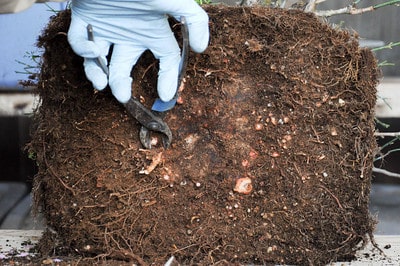
Removing downward-growing roots
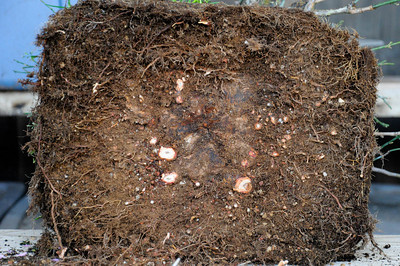
Bottom of the rootball prepared
I cleaned the remainder of the rootball and realized the nebari was developing well. When I first changed the level of the nebari, only three or four large roots emerged from the base of the trunk, the rest emerged a couple of inches higher. Now fine roots circle the trunk. Not necessarily expected of ume bonsai – trees on which deadwood is far more important than roots – but not undesirable either.
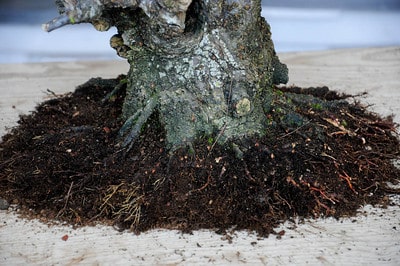
Rootball trimmed
As several years of residue from organic fertilizer displaced most of the bonsai soil left in the roots, I decided to wash the rootball to improve the drainage.
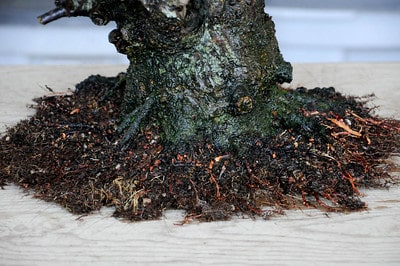
Rootball after washing away excess soil and fertilizer
I set to grafting right after repotting. Here’s a brief step-by step:
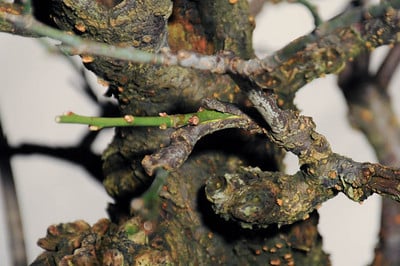
1) Insert scion in branch
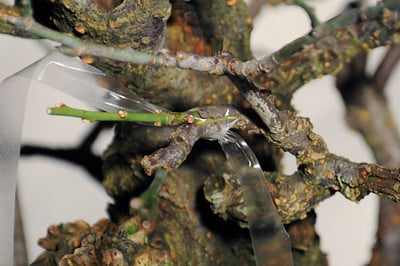
2) Tie scion in place with grafting tape
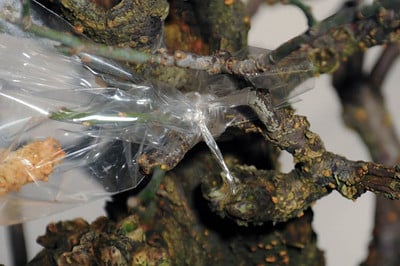
3) Secure grafting bag around scion
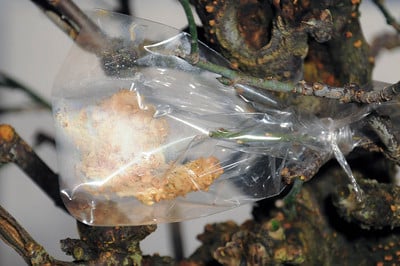
Graft completed – note condensation from moist sphagnum moss in grafting bag
Grafting and cutback really cleaned up the tree. Here’s how it ended up.
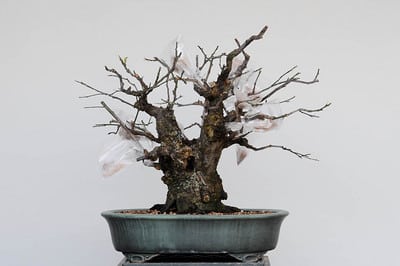
Ume after grafting and repotting
I’ll have a good idea of which scions will make it around Fall. Some usually brown out immediately, others offer a green tease and then flame out in summer. If the grafts make it to Fall, I can usually count on their success. The goal is to get enough in place to begin thinking about showing the tree at a future BIB exhibit. When that time comes, I have just the pot in mind – a yellow oval I picked up in Japan last year – great motivation for me to keep up the work.
Subscribe to Bonsai Tonight
New Posts Delivered Every Tuesday and Friday
David says
Great post, tx!
Tree is coming very nice. I heard ume’s are the hardest species to look after, do you that experience also? Do you handle them differently then other species?
xwires says
Thanks David. Ume aren’t hard to care for, but they are hard to maintain as bonsai. They’re quite vigorous and take advantage of lots of fertilizer and water. The trick is wiring new shoots before they harden and trimming them before they get too long – the mistake I made a couple of years ago.
@Robin – the pot is a Chinese import I purchased from Jim Gremel. The clay is of surprisingly good quality for such an affordable pot.
Robin says
Hello Jonas,
What pretty blooms! They look especially nice against the contrasting bark. I have to ask, whos the potter?
Alex V says
Hey Jonas,
The Ume is looking great. I can’t wait to see it in a show with full blooms. I am curious about its lack of flowering with the original pinks. I was thinking it might be an age or maturity thing, cold that be it? I have about 20 Ume cuttings out in my greenhouse that are about to bloom, but I have no idea how old the tree the cuttings came from was, and I believe cuttings behave as the same maturity as the donor tree.
As always, great post. I am looking forward to seeing this tree in the future. America needs more high quality Ume!
Alex
xwires says
Thanks Alex – both weather and maturity have an effect on when and how much ume bloom. Even now I’m only getting pink blossoms on a few branches, but the white blooms show up pretty regularly. I have a Japanese plum that is similar in growth habit but much older. Some years it’s covered with blooms, other years I only get a handful. I’ve noticed the same pattern on a number of ume from the same batch. Something between age, climate, care and genetics is at play. Here’s hoping your cuttings bloom early and often.
Janet Roth says
Hi Jonas, fwiw my Santa Rosa plum generally takes a break every other year or so from blooming and bearing heavily in the other years. As you know, it is quite an old tree.
I believe that is common with stone fruit trees, so maybe that is part of what you are observing? (While ume bonsai are not grown for their fruit, and we remove the blooms before any develop, in real life they do bear fruit).
Aahhh – right now as I look out my window the tree is covered with beautiful white blooms. I think all my friends had better be prepared for bags of sweet, juicy plums right around July 4 !